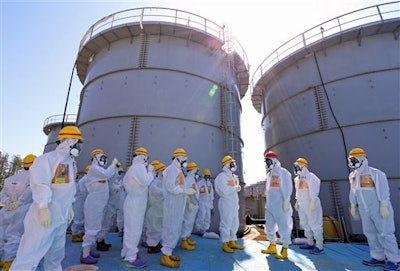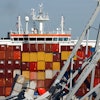
OKUMA, Japan (AP) -- Japanese Prime Minister Shinzo Abe ordered the operator of the country's crippled nuclear power plant Thursday to scrap all six reactors at the site instead of just four already slated for decommissioning and to concentrate on tackling pressing issues like radioactive water leaks.
After taking a firsthand look at the Fukushima Dai-ichi plant, however, Abe insisted that radiation-contaminated water had been contained at the complex and said he would fend off "rumors" regarding Fukushima's safety.
Following a three-hour tour of the plant, Abe instructed its operator, Tokyo Electric Power Co., to decommission the Nos. 5 and 6 reactors, which survived the March 2011 earthquake and tsunami. The disaster caused three other reactors to melt and damaged a fuel cooling pool at another. TEPCO has been unsure about what to do with the two surviving reactors, leading some to believe that it may be still be hanging on to hopes of keeping them alive.
"I told (TEPCO) to ensure decommissioning of reactors No. 5 and 6 so that they can concentrate more on dealing with the accident," Abe told workers and reporters as he wrapped up the tour at the plant's emergency command center.
TEPCO President Naomi Hirose told Abe that a decision on the reactors would be made by the end of the year, the prime minister said.
Abe said that he urged TEPCO to ensure it has enough funding on hand to take care of urgent work needed to clear the way for the plant's decommissioning, and that Hirose promised to obtain 1 trillion yen ($10 billion).
The prime minister said he stood by the reassurance about Tokyo's safety that he gave to the International Olympic Committee before the city of 35 million was awarded the right to host the 2020 summer games earlier this month.
"One of the main purposes of this visit was to see it for myself, after I made those remarks on how the contaminated water has been handled," Abe said.
Officials have acknowledged that radiation-contaminated groundwater has been seeping into the Pacific since soon after meltdowns and explosions crippled the plant following earthquake and tsunami.
Abe said he was convinced that all of the contaminated water had been contained.
"In light of that, I will work hard to counter rumors questioning the safety of the Fukushima plant," he said.
During his tour, Abe was shown some of the 1,000 tanks containing radioactive water, water treatment equipment and a chemical dam being installed along the coast — steps meant to contain the water leakage, which experts say is a major obstacle for the decades-long cleanup process.
Abe's adamant reassurance to the IOC that the leaks are "under control" had backfired at home, as many Japanese believe he was glossing over problems at the plant.
Thursday's plant visit was Abe's second since taking office in December, when he took his first tour on a bus.
Hours before the IOC chose Tokyo to host the 2020 Olympics, Abe gave a speech declaring that radioactive contaminants from the leakage had no impact on seawater outside the bay near the plant. Tokyo was not at risk, he insisted.
Senior TEPCO official Kazuhiko Yamashita told opposition Democratic Party of Japan lawmakers last week that the water situation was "not under control," appearing to contradict Abe. DPJ leaders said they would demand that Abe explain his remarks to the IOC.
TEPCO later said Yamashita was referring to isolated incidents and had not contradicted Abe's comments.
The most heavily radiated water pools inside the reactor and turbine basements, where waste cooling water that leaked out of melted reactors has gathered, have mixed with groundwater seeping through cracks in the damaged buildings, generating 800 tons of contaminated water per day.
Much of the water is being pumped out and partially treated — half is recycled as cooling water, the other half stored in tanks. The plant has 350,000 tons of water kept in the 1,000 tanks.
The chairman of Japan's Nuclear Regulation Authority, Shunichi Tanaka, has proposed using a new water treatment machine capable of removing all radioactive elements apart from less toxic tritium so the water can be eventually released into the ocean once it is safe enough.
Meanwhile, the government is funding the development of more advanced water treatment equipment and paying for a costly ice wall to surround the reactor and turbine buildings and prevent them from contaminating outside groundwater.






















